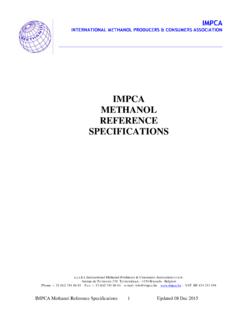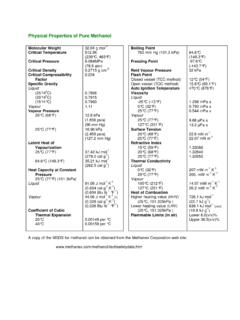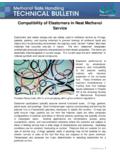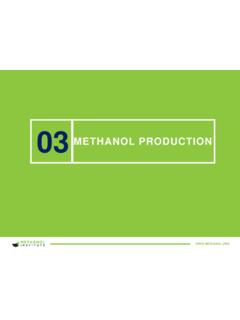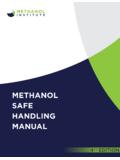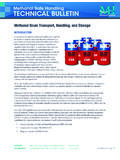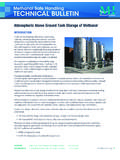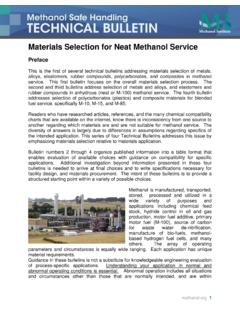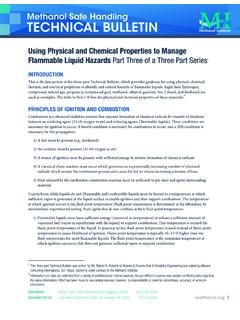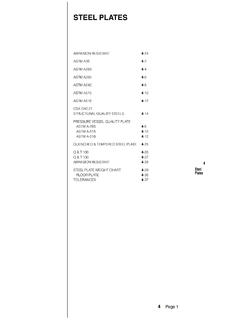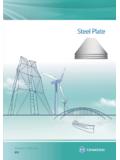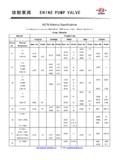Transcription of Compatibility of Metals & Alloys in Neat Methanol …
1 1 Compatibility of Metals & Alloys in Neat Methanol Service There are about a dozen classes of Alloys that are appropriate for neat Methanol service. Some Alloys are appropriate for a variety of applications; others are suitable for a narrow range of service. Service applications are: storage- tanks, totes, drums 5 gallon buckets, and 1 gallon cans; transportation- ships, barges, rail cars, tanker trucks, totes, drums, and cans; processing- pressure vessels, columns, shell and tube heat exchangers, plate and frame heat exchangers, piping and fittings, valves, process sensors and transmitters; and transfer (machinery)- compressors, pumps, and fans.
2 A large number of the Alloys listed in the Table 1, Metals and Alloys Compatibility Table, are suitable as pump and valve trim, and as bellows, gaskets, and seals to contain pressurized fluids. By comparison, a list of Alloys suitable for fabrication of Process Flow Diagram (PFD) and Piping and Instrument Diagram (P&ID) tag-numbered equipment items is short. Brief descriptions of commonly used alloy groups are presented below. Examples of Alloys used in a variety of applications and their Compatibility ranking for applications involving neat Methanol are presented in Table 1.
3 Physical properties such as yield strength, ultimate tensile strength, elasticity, toughness, etc., and chemical Compatibility ( , corrosion resistance) of Metals and Alloys is determined by selection of a particular base metal (aluminum, copper, iron, lead, and titanium), and relative abundance of specific alloying elements within the base metal : , argon (Ar), aluminum (Al), boron (B), carbon (C), columbium (Cb), cobalt (Co), chromium (Cr), copper (Cu), cesium (Ce), magnesium (Mg), manganese (Mn), molybdenum (Mo), nitrogen (N), niobium (Nb), nickel (Ni), lead (Pb), antimony (Sb), silicon (Si), tin (Sn), tellurium (Te), titanium (Ti), vanadium (V), tungsten (W), zinc (Zn), and zirconium (Zr).
4 Base metal elements in one group of Alloys may be alloying elements in a second group, or contaminants in a third group. Materials Selection for Neat Methanol Service (cont.) 2 Alloy composition, method of manufacture, thermal history, post solidification heat treatment, etc. determine crystal lattice structure, atomic packing density, grain size, phase abundance, and microstructure. Grain size and microstructure dictate physical properties, and in combination with circumstances of application, determine useful life, and failure mode ( , stress cracking, hydrogen embrittlement, fatigue, creep, etc.)
5 Failure mode is determined by a combination of stress loading, alloy properties, uniformity of alloy composition near the grain boundaries, relative phase abundance, and chemical Compatibility within the service environment. It is not always possible to presuppose how a particular alloy will perform in a particular application. For this reason, experience is a fundamental determinate in predicting when and how Alloys will fail. Typically, experience is determined by a combination of testing and reviewing prior service experience.
6 The one certainty is that given sufficient time, all metal Alloys will fail. Carbon Steels Iron is the base metal for carbon steels. Carbon ( C)is the primary interstitial alloying constituent in carbon steels, along with no minimum content specified or required for chromium (Cr), cobalt (CO), molybdenum (Mo), nickel (Ni), niobium (Nb), tungsten (W), vanadium (V) and zirconium (Zr). Maximum contents for copper (Cu), manganese (Mn) and silicon (Si) are , , and wt/percentage respectively.
7 Two fundamental conventions relative to alloying, melting, solidifying, cooling, tempering, and aging Metals are too little of a good thing is a bad thing, and too much of a good thing is a bad thing. Because multiple factors determine a particular set of alloy properties, it is necessary to control alloy composition and each stage of the production process in order to produce product with the desired properties. The ultimate success is determined by chemical analysis, micrographic inspection, and mechanical testing to verify that the desired properties are achieved.
8 Alloy formulation, thermal history, and property verification is stipulated in standards such as those published by American Society of Testing and Materials International (ASTM). In selecting Metals and Alloys it is necessary to specify the alloy ( , American Iron and Steel Institute (AISI) 1020 carbon steel, 304 stainless steel, nodular cast iron, etc.), and the code that is appropriate for your application. Molten iron and molten steel contain dissolved gases, which cause boiling of liquid metal during pouring, solidification, and cooling.
9 These steels are termed unkilled or Materials Selection for Neat Methanol Service (cont.) 3 wild steels. Addition of oxygen scavengers, ( , Si, and/or Al) to the molten metal removes the gases, thereby preventing boiling and allowing the molten liquid to solidify with fewer defects and smaller grain size. So-called killed steels are cleaner, exhibit superior mechanical properties, and are therefore generally used in preference to unkilled steels. ASTM A106 pipe, A105 forgings, and A516 plate are examples of killed steel.
10 Unkilled and semi-killed steels are permitted in benign services. ASTM A53 and American Petroleum Institute (API) 5L pipe and ASTM A36 structural steel are examples of semikilled steels. Unkilled versus killed steel continues to be important in terms of code compliance; however, as a practical matter, more than 95% of world steel production uses continuous casting and all continuously cast steels are killed as an inherent aspect of the process. In order to resolve issues of recognized equivalence between coding systems, metal alloy products can be stenciled to indicate compliance with multiple codes.
